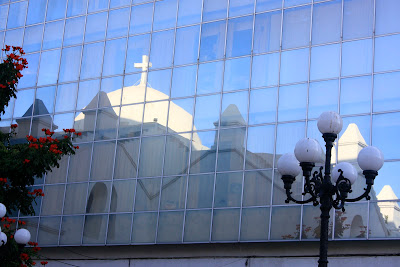Prefer land to land fill
On the 23rd 4 of us departed Chiapas for Guatemala. After a 6 hour bus ride we arrived to the border, stamped our passports, switched buses and we were off to Quetzaltenango. These neighbouring countries once, and still somewhat shared the same Mayan culture. I was not expecting too much of a difference. The first thing that struck me was magnificent and wondrous mountain ranges. They were huge and went on for miles. The second thing that struck me was the garbage. Within the first 20 minutes we passed a dump, mounds or garbage being dumped over a cliff. I wondered where the run off went and the I thought of Recycled Life, a documentary about generations of families that were ostracized and living in a land fill in Guatemala City. They resorted to uncovering what they could reused or exchanged for compensation. Although a miserable way to live, it is not completely without merit.
Our first venture after exploring some of the city was to Volcan Santa Maria. We left our hostel at 6am and tried to get there for sunrise. We decided to attempt it without a guide. The locals are friendly and helpful here and went out of their way to guide us up and assure we did not get lost. Even a little dog followed us up to the summit and back down. Again a myriad of garbage littered the trails. We saw almost no tourists on the trek up until we were almost to the top. We ran into a group of students from Minnesota. They were with a guide from a volunteer organization and had left at 11:30 the night before, trekked up at night to summit for the morning sunrise. With this voluntary program they picked up garbage around the summit. They all came down with one or two full garbage bags. I asked if they had learned anything in their program about the dynamics of the garbage system in this country. They said no but that it was a problem with the locals, that they just take all of their garbage there and just toss it wherever. They speak as though it was their ignorance or cultural anomaly that had created this problem. I can understand that in the time it takes to fill a few garbage bags with garbage, some resentment toward the problem may develop. We got an empty garbage bag from the guide with their group.
At the top of the mountain were about 50 local people practicing a religious event that coincides with the Mayan Calendar day of prosperity and economics. Some were gathered around for a sermon, some elderly women practicing their own sacred practice in a child’s pose like prayer. Other families gathered together as the children played and laughed and threw paper airplanes into the clouds. All these people make this challenging hike to be is this sacred place for this event. Why would they intentionally pollute it?
On our hike down the mountain we filled our garbage bag. Not in resentment for how the locals had left it, more as a thank you to mother earth for creating the mountains, beautiful views and clouds that we were fortunate enough to experience. Also for the marvelous balance that she created that the human race had taken for granted. Among the things that littered the trail, which coincided with what litter along the highways;
Almost all plastic- or Polyethylene created in 1933 by two chemists, E.W. Fawcett and R.O. Gibson working for the Imperial Chemical Industries Research Laboratory (in 1926 four major chemical companies in Great Britain merge to become Imperial Chemical Industries, ICI). In 1936, Imperial Chemical Industries developed a large-volume compressor that made the production of vast quantities of polyethylene possible. Today, polyethylene is used to make such common items as soda bottles, milk jugs and grocery and dry-cleaning bags in addition to plastic food storage containers. It decomposes to create a more harmful and toxic chemical, which will return to the earth and the inevitably food chain.
Snack foods packaging- Potato chips, chocolate bars, candies. US demand for snack food packaging is projected to advance 3.7 percent per year to $5.6 billion in 2010.($4.7 billion, 2005)
Plastic bags- Can be found dating back to the early 1950s in the United States and Europe, the invention of Swedish engineer Sten Gustaf Thulin often made from polyethylene intended for one single use to carry items from a store to a home.
Bottled or bagged water- 1845 Poland Spings first founded when Maine summer visitors wanted to return home with spring water.
1863- Perrier was first bottled by the decree of Napolean III for “the good of France”. Is now found around the world and has created an unhealthy dependence while our natural water sources become polluted and privatized.
Pop bottles- Nathaniel Wyeth's invention. Nat Wyeth was born near Chadds Ford, Pennsylvania. Wyeth began work on his best-known invention in 1967.
Perhaps it is not the ignorance and cultural anomaly of the local culture. Perhaps it is a clash of another more ignorant, more maladaptive culture that has taken the world by storm. It is this that the world is not equipped to handle. The evidence of the world before this is still present on the trail and it comes in a form of more balanced debris. Banana leaves and corn husks that were once predominantly used to wrap snacks, ones that would return to the earth with no adverse effects.
Thanks NAFTA for the abundance of accessible and affordable garbage!
Thanks NAFTA for the abundance of accessible and affordable garbage!


Comments
Post a Comment